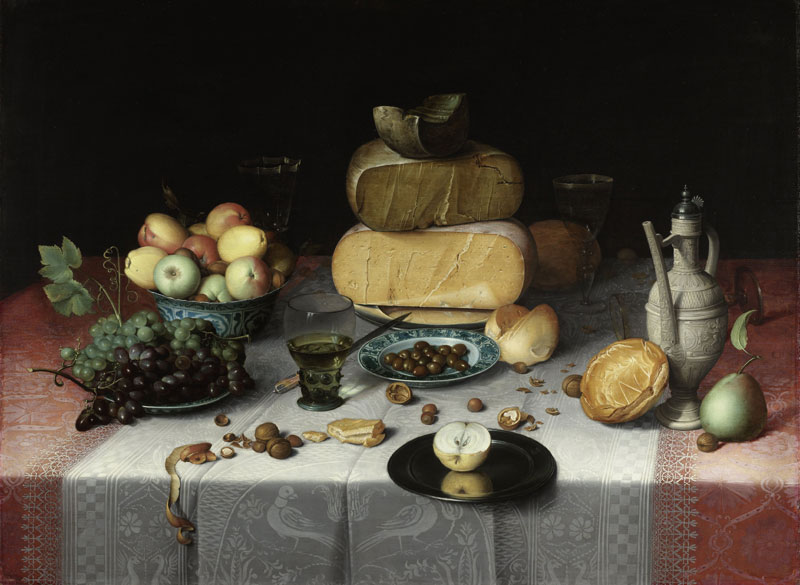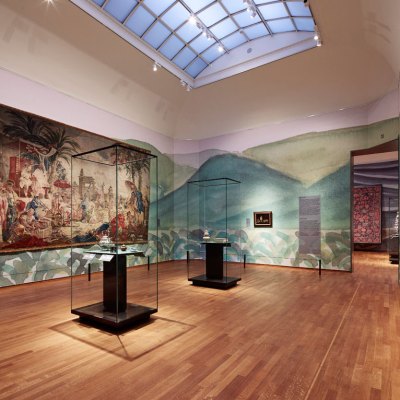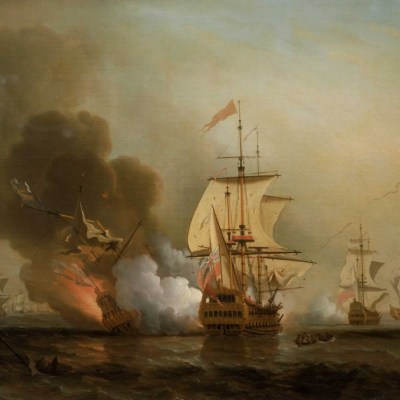From the November issue of Apollo: preview and subscribe here
The Santa Catarina brought the first large shipment of porcelain from the Far East to Europe, creating a demand for new luxury goods, which feature in paintings of the Dutch Golden Age
A quick survey of Dutch paintings of the 16th and 17th centuries reveals a change that took place in around 1604. Things – especially luxurious objects – begin to creep into the domestic spaces of Dutch interiors. Their presence is so independent and assertive that the still life has to be invented to contain them. Conspicuous among these luxuries are the beautiful objects, of which porcelains are the most striking, arriving in Amsterdam by ship from the Far East. To tell the story of this turning point in taste, there is no better place to start than in the port of Bantam on the island of Java.
After coming off the first watch on the evening of 28 May 1604, the English trader Edmund Scott was asleep when one of his men uttered the one word he had forbidden them ever from using in jest. ‘Oh this word Fire!’ he recalled two years later, in the first memoir by an Englishman trading in the Far East. (His publisher Walter Burre, besides being brother-in-law to Scott’s commander, Henry Middleton, was the publisher of Ben Jonson and Walter Raleigh.) ‘Had it been spoken near me either in English, Malay, Javan, or Chinese, although I had been sound asleep, yet I should have leaped out of my bed: the which I have done some times when the men in our watch have but whispered one to another of fire.’
Scott had sailed east in 1601 with the first voyage of the East India Company and been left at the Company’s new ‘factory’ or trading station, in Bantam, west of today’s Jakarta. The factory consisted of an impressive two-storey house, 36 feet wide and twice as long, plus some smaller buildings and a pond, all surrounded by a security fence and ditch. Bantam was intended to be the anchor of a string of ports where the Company hoped to gain footholds to enter the China trade in the early 17th century. Scott was appointed head of the factory in June 1603, after all eight of the original factors had died, and as of May 1604 commanded nine men and a boy.
The watchman explained to Scott that he and his mates had ‘felt a strong funk of fire’. When they yanked open the door to the pepper house, they had been hit by a surge of heat, but couldn’t find the flame. Nor was anything in the kitchen burning. Then one of them remembered a rat hole behind a trunk that ran from the kitchen down through the ceiling of the cloth warehouse below. When they pulled the trunk away from the wall, they saw a plume of smoke wafting out of the hole. Scott rushed downstairs and threw open the doors to the cloth warehouse, ‘Whereat came out such a strong funk and smoke that had almost strangled us: this smoke, by reason it had no vent, was so thick, that we could not perceive whereabouts the fire was.’ The immediate danger were the two kegs of gunpowder that sat just inside the warehouse door. They were hot to the touch, but Scott and his men managed to roll them out and stash them on the far side of the house. When they went back into the warehouse, their candles guttered out for lack of oxygen, but they set to work removing the bundles of Chinese silk stored there.
Some of Scott’s Chinese neighbours – merchants, like him, from away but who, unlike him, had settled in Bantam – had meanwhile gathered outside the compound to see what was going on. Somewhat against his better judgement, Scott decided to ask for their help. They responded by offering advice: why didn’t he break a hole in the roof and pour in water? (He declined for fear a hole would give the smouldering fire a natural chimney, causing it to flare up and consume everything inside.) Why didn’t he let them knock down the walls? (He suspected this would turn the rescue of his goods into a free-for-all.) Eventually they agreed to get the silk out of the warehouse, though Scott had to make sure they didn’t throw it over the fence into the neighbouring compound. Chinese and Englishmen together successfully extracted over 50 bundles of silk, of which two-thirds were undamaged, from the smoking warehouse.
While this was going on, Scott suddenly recalled the thousand pounds in gold hidden in a chest in his bedchamber. Fearing the light fingers of the men now wandering around the compound, he raced upstairs thinking to throw it in the pond, so that it would lie undetected until the crisis was over. Changing his mind just as he got to his room, he went back down to discover some Chinese merchants in the dining room. They had moved the dining table to one side and were tearing up the floorboards in order to break through the brick ceiling of the warehouse beneath. He chased them out, though he offered to pay anyone who helped with emptying the warehouse – but through the door and not the ceiling.
By morning disaster had been averted and the fire was out, but Scott was curious why it had started. Some Chinese told him it was because he did not make daily sacrifices to God – which he assured them he did. A better answer arrived later that morning when an English surgeon working in Bantam dropped by to share a conversation he had had with a Dutch patient. This patient had in turn been told by a Chinese bricklayer that the Chinese had set the warehouse on fire, though he didn’t know how. The surgeon asked to see the room in the cloth warehouse where the heat and smoke had been most concentrated. He discovered that a small round hole had been bored through one of the floorboards. Scott stuck a thin pole through the hole and could not touch bottom, so they pried up the board quietly to investigate. Directly underneath was a passage – Scott calls it a ‘mine’ – that had been dug from the Chinese house on the south side of the property. It was big enough for the largest chests to be carried out of the warehouse.
‘As secretly as I could,’ wrote Scott, ‘I called three of our men, and went to the house from whence the mine came. Having our weapons, I set one in the door, and charged him he should let none come out, whatsoever he were, and myself with the other two went in.’ There they found three men. ‘One was a dweller in the house, but the other two we could prove nothing against them.’ Under torture the first admitted that they had tunnelled under the warehouse to empty it from below. It was only with the final step – removing the floorboards – that they had gone wrong. Fearing that sawing would alert the English, they had decided to try slow burning – a poor choice, as it turned out. On his way to his execution, the condemned man exclaimed to the crowds that gathered to watch him die that the Chinese were right to rob Englishmen: the English were rich and the Chinese poor.
This is one of many stories recounting the intense mistrust and instability in these early trading communities, where Chinese controlled the supply of commodities and labour and Europeans sought to control demand. But what caught my attention is a parenthetical remark in which Scott mentions that he had received the gold ‘of General Hemskerke for pepper’. This is a significant and exciting detail that tells a much larger story. Van Heemskerck appears at one earlier point in the memoir, on 14 October 1603, when Scott writes that the Dutch admiral had set sail from Bantam for Amsterdam. Jakob van Heemskerck was a Dutch commander who had been sent east by the VOC (the Dutch East India Company) to break the Portuguese hold over the spice trade. Failing in that task, he had bought 5,000 sacks of pepper from dealers in Bantam, including Scott (from whom he bought a thousand sacks for a thousand pounds). Scott mentions that of the six ships in van Heemskerck’s departing convoy, one was a ‘ship of Mackow [Macao] which he had taken’. He doesn’t name the captured Portuguese ship, but it is not hard to identify it as the Santa Catarina, which was about to make history when it got in to Amsterdam.
The Santa Catarina was an enormous 1,400-ton carrack on its way home from the Portuguese port of Macao on the south China coast to Lisbon. Van Heemskerck had seized it off the coast of Singapore on 23 February 1603. It was a skilful capture: deaths were few, hostages were repatriated, and its cargo was undamaged. Van Heemskerck brought his prize to Bantam on 20 June, then set sail four months later for Amsterdam. It was a record-setting haul. The Santa Catarina carried 1,200 bales of raw silk, many chests of damasks and embroideries, innumerable sacks of spices and sugar, and 60 tons of porcelain. At public auction, according to the historian Peter Borschberg, the cargo netted an amount equal to half the paid-in capital of the VOC – and over twice that of its English counterpart. The ship also carried 70 tons of gold. (Scott probably had looted Portuguese gold in his chest.)
The Santa Catarina captured the attention of Amsterdam and indeed all of northern Europe, for out of it came the first large shipment of Chinese porcelain to Europe. This was the first porcelain many Europeans had ever seen, and they were amazed. But the Santa Catarina delivered something besides porcelain that had a lasting impact – and that was an important legal decision. Portugal declared the taking of the Santa Catarina to be an illegal seizure and sued to get it back; the Admiralty Court in Amsterdam pronounced its judgement on 9 September 1604, declaring that the ship and its cargo was legitimate war booty. One could hardly have expected the Dutch judges to rule against the VOC. The Company, however, recognised the shakiness of its legal claim and commissioned a young law student to write a more definitive legal opinion.
That student was Huig de Groot, not yet known by the Latinised version of his name, Grotius. He produced a massive treatise on the question of war booty, of which a single chapter was published in 1609 as Mare Liberum, (The Free Sea). The nub of de Groot’s argument was that trade was a right, and that restriction of that right was a casus belli. Thus was born a doctrine of free trade that would cause havoc across the globe – all in defence of a highly dubious claim. The English regarded de Groot’s opinion as nothing but a legal cover for Dutch piracy. In 1635, the brilliant jurist John Selden answered de Groot with Mare Clausum (The Closed Sea), thus inaugurating the modern history of international law – but that is another story.
These were the sorts of events – adventurous, legal, and commercial – that shaped Amsterdam’s budding relationship with Asia, now the subject of an exhibition at the Rijksmuseum, ‘Asia in Amsterdam: Luxury in the Golden Age’ (17 October–17 January 2016). The age was not golden for those tunnelling under Scott’s warehouse, nor for the sailors who died defending the Santa Catarina from van Heemskerck, but for the Dutch commercial class buoyed by the new Asian trade, the age glittered as never before with gold, silks, and porcelains the VOC brought home.
The Return to Amsterdam of the Second Expedition to the East Indies (1599), Hendrik Cornelisz Vroom. Oil on canvas, Rijksmuseum, Amsterdam

The exhibition displays some of these objects, including a remarkable sleeve of Chinese silk of the sort that Scott saved from his smouldering warehouse. But the most striking portraits of this period are the oil paintings that celebrate the new age. Hendrik Vroom’s splendid The Return to Amsterdam of the Second Expedition to the East Indies (1599), painted five years before van Heemskerck’s triumphant return, communicates the pride and excitement the Dutch felt over their success abroad, which coincided with their success in escaping Spanish imperialism at home.
The transformation is even better captured on a more intimate level in the still lifes and domestic scenes that the newly rich commissioned to display their prosperity and good taste. What better to parade that good taste than Chinese porcelain? Clara Peeters’ visually insistent Still Life with Cheeses, Almonds and Pretzels (c. 1615), painted just a few years after the Santa Catarina was unloaded, foregrounds a blue-and-white klapsmut, a type of shallow bowl that the potters of Jingdezhen in China produced specifically for export. We cannot be certain whether the Santa Catarina brought it to Amsterdam, but it is a likely source. Jan Brueghel produced Still Life with Bouquet of Flowers in a Blue Vase (1608–10); not just any blue vase, but another Jingdezhen blue-and-white that probably came from the Dutch carrack. Floris van Dijck trumped both by depicting not one, but three pieces of Chinese porcelain in his Still Life with Cheese of around 1615. Within a few decades, as La Visite (c. 1630–35) by an anonymous hand demonstrates, prosperous householders did not just display a precious few porcelains about the public rooms of their houses but surrounded themselves with it. As Chinese dishes became more available, blue-and-white pieces colonised other locations in Dutch homes, besides breakfast sideboards or plate rails. As Pieter de Hooch’s Portrait of a Family Playing Music (1663) shows, they found their way on to mantels, lintels, and even cupboard corners. No prosperous Dutch home was complete without these decorative touches. For the less fortunate, their demand was what Delftware was invented to satisfy.
Still Life with Cheese (c. 1615), Floris Claesz. van Dijck, (c. 1580/1590–c. 1621), oil on panel, 82.2 × 111.2cm. Rijksmuseum, Amsterdam

When Edmund Scott arrived back in London in 1605, he published his memoir and disappeared from public record. On the subject of porcelain, which he does not mention once in his book, he missed the boat, as it were. In those early years of trading in Asia, European merchants neither dealt in fine porcelain, nor even noticed it. Scott wasn’t to know that it would take Amsterdam and London by storm. What he knew was that a sack of pepper was worth a pound of gold in Bantam, but worth its weight in gold back home. This may explain why he didn’t bother throwing his gold in the pond – who knew what tricks his neighbours might pull to sneak into the treasury that was his pepper house?
Timothy Brook is a Canadian historian of China. His most recent book is Mr Selden’s Map of China: the spice trade, a lost chart & the South China Sea (Profile Books).
‘Asia in Amsterdam: Luxury in the Golden Age’ is at the Rijksmuseum, Amsterdam, from 17 October until 17 January 2016.


